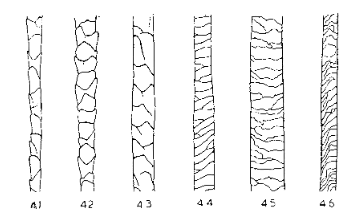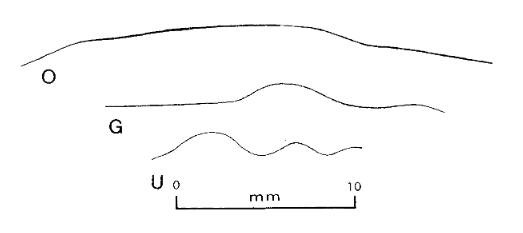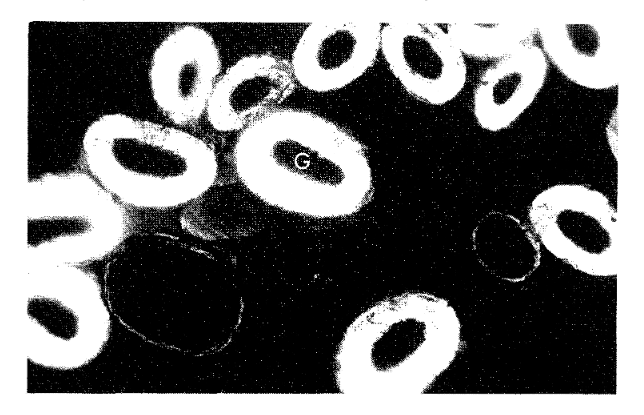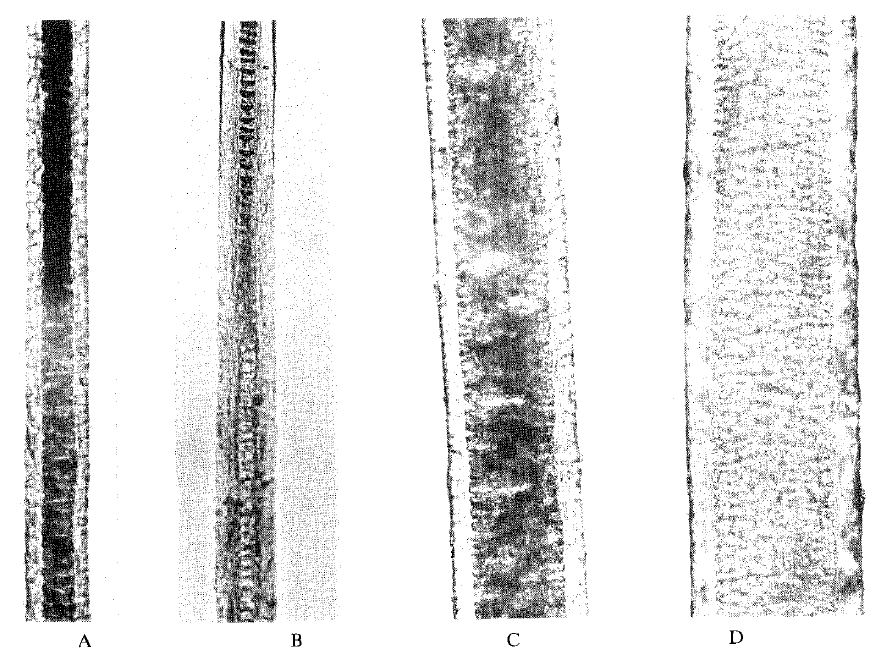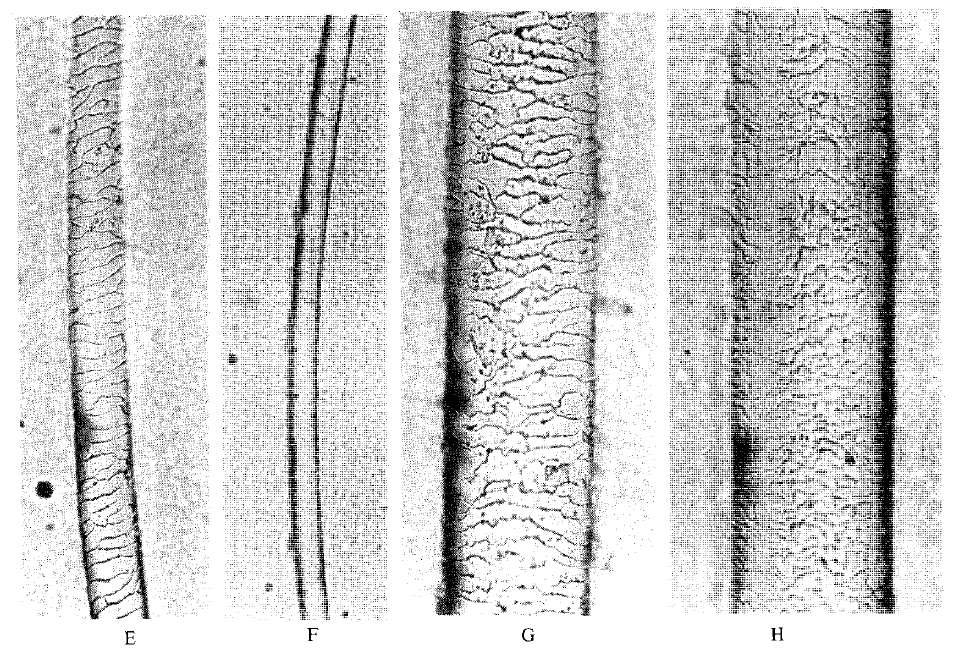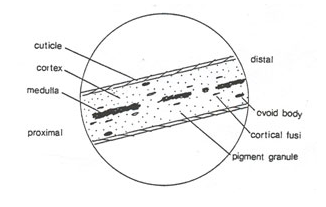Hair identification and morphology for the Tasmanian tiger
Two key texts exist describing hair morphology and identification for the thylacine (Tasmanian tiger; Thylacinus cynocephalus) -
- Lyne, AG and McMahon, TS (1950) Observations on the surface structure of the hairs of Tasmanian monotremes and marsupials. Papers and Proceedings of the Royal Society of Tasmania. pp. 71-84. ISSN 0080-4703
- Taylor, Robert J (1985) Identification of the hair of Tasmanian mammals. Papers and Proceedings of the Royal Society of Tasmania 119, 1985. pp.69-82. 0080-4703
In relation to the thylacine, the first paper provides illustrations of the surface morphology of numerous hair types while the second provides a diagnostic key via text descriptions.
Illustrations of Tasmanian tiger hair surface morphology
Figures 41 through 46 from Lyne & McMahon illustrate surface morphology for the hair types described below. The original paper included a scale of "x 100" which is unhelpful where reproduced images may be scaled (ie. in the PDF version of the paper; on this website; on any particular screen used for viewing this page or the paper).
| Figure | Description | Figure | Desciption |
|---|---|---|---|
| 41 | Wavy hair; basal | 44 | Wavy hair; distal |
| 42 | Wavy hair; basal | 45 | Straight hair; distal |
| 43 | Wavy hair; mid-shaft | 46 | Wavy hair; distal |
For the family Dasyuridae, Lyne & McMahon note "There is sometimes an amazing variety of scale forms along a single fur hair". This should make thylacine hair identification via examination of the surface morphology a difficult task and many of the other species in the family present at least some similar forms in the paper (cf. Figures 33, 37 and 44 in the original paper, for Dasyurus maculatus, Sarcophilus harrisii and Thylacinus cynocephalus, respectively). As a result, Taylor's 1985 paper becomes important in distinguishing thylacine hairs from others in the family (see below).
Photographs of Tasmanian tiger hair slide specimens
Gross morphology
Lyne & McMahon note for Dasyurdiae that "in all the Tasmanian representatives of this family, except Thyacinus, the coat is composed of two distinct types of hair". Taylor provides photographs for three hair types: over hair; guard hair; and under hair.
The figure above comes from Taylor and is captioned: Fig. 3 - Thylacinus cynocephalus. Hair profiles: O = over hair; G = guard hair; U = under hair.
It is presumed the above figure comes from a scan of the original paper, which had published photographs, and which has since been presented in PDF format.
Cross sections
The photograph above is of a slide preparation given in Taylor and captioned: Plate 5 - Cross-sections of hairs of Thylacinus cynocephalus.
The images provided here are made more useful when compared with other species. Readers are directed to the source papers (links at top of this page) for this purpose.
Whole mounts showing medulla
Taylor notes the descriptions for a number of other thylacine hair photo examples as follows: "Figures A to D: whole mounts of hairs of Thylacinus cynocephalus. A, under hair in proximal region; B, under hair in distal region; C, primary hair in proximal region; D, primary guard hair in shield region."
Whole mounts showing scale patterns
Taylor continues, "Figures E to H: scale patterns of hairs of Thylacinus cynocephalus. E, under hair in proximal region; F, under hair in distal region; G, primary guard hair in proximal region; H, primary guard hair in mid-shaft region."
Diagnostic key for Tasmanian tiger (thylacine) hair
Taylor gives, in Introduction, the context and value in providing a diagnostic key for the identificaiton of mammalian hair: "Lyne & McMahon (1951) carried out a preliminary investigation of the structure of the hair of Tasmanian marsupials ... but they were unable to achieve their objective of constructing a key ... Brunner & Coman (1974) refined the techniques for hair identification and provided photographs of hair structure which could be used to identify the hair of mammals occurring in Victoria. Similar photographs have also been provided for mammals occurring in the south of Western Australia (Valante & Woolley 1982). The ability to identify hair samples has proved to be an invaluable tool in dietary studies of carnivores (Brunner, Lloyd & Coman, 1975, Jones and Coman, 1981) and in mammal surveys, where hair traces found in hair sampling tubes (Suckling 1978) or in predator scats (Brunner, Amor & Stevens 1976) may be the only method of detecting the presence of a species."
As such, the following diagnostic criteria for Thylacinus cynocephalus have been extracted from Taylor's key which includes forty Tasmanian mammal species - including introduced species but excluding bats and marine mammals.
- Cross-sectional appearance of primary guard hairs is:
- Predominantly oblong in cross section (as opposed to circular or oval)
- Medulla is prominent (as opposed to reduced or lacking)
- Medulla lattice, if present, is unlike that in Hydromis (see Brunner & Coman 1974, page 127); and the length-to-breadth ratio of the cross-section of the hairs is less than 2.5.
- Scale pattern on guard hair is near or close irregular wave (as opposed to a regular pattern, if a wave scale pattern is present); hairs generally less than 25mm long (as opposed to generally greater than 25mm, except for some Bettongia); hair is brown at base, pale sandy colour on upper half with a brown tip or all of hair a pale sandy colour (as opposed to base of hair being grey, or, if brown, then hair being longer than 25mm)
- Thylacine cynocephalus (Tasmanian tiger)
- Scale pattern on guard hair is near or close irregular wave (as opposed to a regular pattern, if a wave scale pattern is present); hairs generally less than 25mm long (as opposed to generally greater than 25mm, except for some Bettongia); hair is brown at base, pale sandy colour on upper half with a brown tip or all of hair a pale sandy colour (as opposed to base of hair being grey, or, if brown, then hair being longer than 25mm)
- Medulla lattice, if present, is unlike that in Hydromis (see Brunner & Coman 1974, page 127); and the length-to-breadth ratio of the cross-section of the hairs is less than 2.5.
- Medulla is prominent (as opposed to reduced or lacking)
- Predominantly oblong in cross section (as opposed to circular or oval)
Hair structure and terminology
In order to understand some of the terms utilised in the key above, the FBI article Microscopy of Hair Part II: A Practical Guide and Manual for Animal Hairs explains that:
"Hair can be defined as a slender, thread-like outgrowth from a follicle in the skin of mammals. Composed mainly of keratin, it has three morphological regions—the cuticle, medulla, and cortex. These regions are illustrated ... with some of the basic structures found in them. The illustration is a diagram used to emphasize structural features ... Certain structures may be omitted, and others enhanced for illustrative purposes."
The above figure illustrates the FBI article and is captioned: Figure 82. Hair Diagram.
